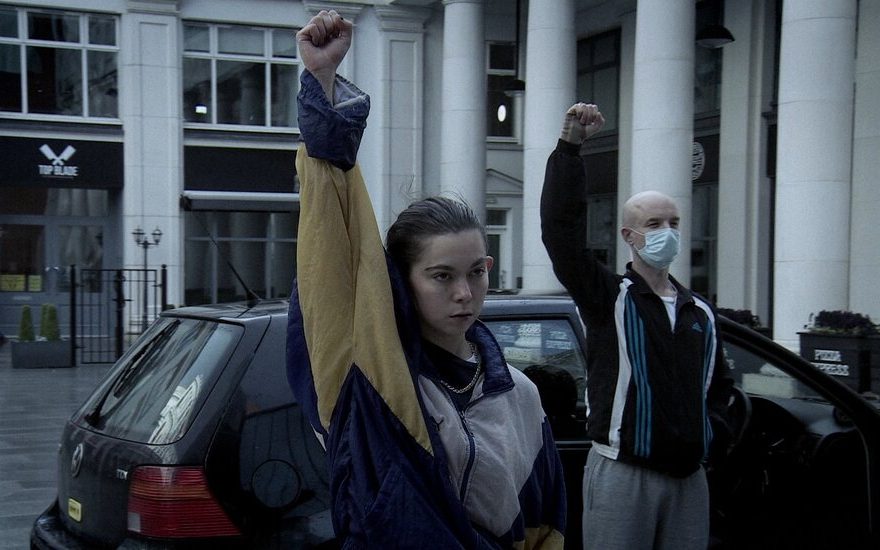The context of the pandemic provides “Dancing Nation” with the common themes of loss, touch and confinement.


By Brian Seibert
When one door closes, another opens. During the pandemic, that maxim has acquired a corollary for concert dance: When theater doors shut, digital portals proliferate. With Britain is in another lockdown, Sadler’s Wells Theater in London is shut to audiences, but its dance programming is now accessible on its website for free, at least in the form of a tasting menu, three hourlong shows called “Dancing Nation.”
For London audiences, it’s partly a take-what-you-can-get substitute. But for the rest of the world, this is something we didn’t have before, certainly not in so convenient a package: an opportunity to sample British dance. And the selections, most filmed at the theater recently, are clearly designed as a sampler: big national institutions alongside upstarts, a range of styles, a geographical spread.
“You don’t think of the U.K. as a dancing nation, but it is,” Alistair Spalding, the artistic director of Sadler’s Wells, says in the first episode. That statement is telling. These are shows that profess to believe in dance (and take pride in the local scene) but presume that audiences don’t — that they need to be sold.
“Dancing Nation” is a collaboration with BBC Arts, and the programs have the feel of a BBC travel show. The veteran correspondent Brenda Emmanus hosts, introducing each piece with boosterish adjectives (“astonishing,” “groundbreaking”), brochure descriptions (“a powerful piece about a couple dealing with depression”) and instructions on how to react (“once seen, never forgotten”). After each dance, she continues the hand holding, repeating some of those elements, just in case.
Before some footage, Emmanus interviews choreographers and artistic directors, checking in on how they’ve been surviving, on who was able to put on live shows between lockdowns, on how they’ve converted to digital. Nothing really rises above polite chitchat, but in this way the shows deliver a little contextual padding, a little news.
In all, it’s a reassuring product, welcoming a broad audience with conventions of bland professionalism. That’s surely useful — would that PBS apply the same to American dance!— but I couldn’t help but wish for something more artful, if not more challenging, something more trusting of dance to justify itself.
As for the dances themselves, they are unsurprisingly a mixed bag. Almost all samplers are, and this one has a fast-forward option. What’s distinctive here is the context of the pandemic: the common themes of loss, touch and confinement, and how each work, in that context, strains for relevance.

The best program is the second one, and not only because it contains the star pairing of Akram Khan and Natalia Osipova, together for the first time. His “Mud of Sorrow: Touch” starts with recited text: “Who will remember the history of touch?” And touch they do. The melding of his kathak-contemporary style with her ballet results in a four-armed creature, part Shiva, part swan. That’s striking, though it’s more moving when they dance in simple ballroom position, and when she leaves and his arms go empty.
The second program also includes part of “Hope Hunt and the Ascension into Lazarus” by the breakout Belfast choreographer Oona Doherty. A woman rolls out of the back of a car and postures like a working-class man. The excerpt is truncated, but it serves to introduce an important, original voice and also to confirm its power, since the piece retains its force without the choreographer in the calling-card role she originated.
The second program is representative too in presenting strong hip-hop and weak ballet. “Lazuli Sky,” a new work by Will Tuckett for Birmingham Royal Ballet, is fluid, conventionally pretty and entirely ordinary. But a section of “Blak Whyte Gray,” a 2017 work by the hip-hop troupe Boy Blue, is still urgent, a trio of precise robots, prisoners who inspire empathy as puppets do.
And a piece of “BLKDOG,” a 2018 effort by Far From the Norm, is enough to establish its choreographer, Botis Seva, as a major new talent. Hooded figures sit, shake, run, fall. When they cover ground quickly in a squat, knees pistoning, feet scurrying like a ballerina’s in bourrées, it’s the most piercing moment of dance action in the whole festival.
For strongest selection in the festival, “BLKDOG” is in competition with Matsena Productions’ “Shades of Blue,” which begins the third episode. Contemporary hip-hop has its conventions, too, like this work’s prison cells of light and zombie motion. The image of a police officer standing on a Black man’s back is all too familiar. But the chaotic repetitions of protest and imprisonment capture an emotion of 2020 better than anything else in “Dancing Nation.” At the end, a Black man soliloquizes to an empty auditorium. “Are you numb?” he asks. The silence, he says, is frightening.
Nothing else in the third program cuts through like that. Not Northern Ballet’s “States of Mind,” with its hokey voice-over about pandemic loneliness and the healing power of love. Not Shobana Jeyasingh’s “Contagion,” a 2018 evocation of the 1918 Spanish Flu. And certainly not Rambert’s new “Rouge,” in which Marion Motin’s music-video moves stagnate without music-video editing.
The first episode is the feeblest, and the anomaly, in the sense that the ballet is solid (Matthew Bourne’s “Spitfire,” a funny 1988 sendup of male vanity and underwear ads) and the hip-hop is wispy (a trip through the Sadler’s Wells building, courtesy of Breakin’ Convention).
Despite the faults and limitations of “Dancing Nation,” a dance lover across an ocean from London can be grateful for it. It’s too soon to say whether such presentations will continue after the pandemic. Asked about what’s most needed, Jonzi D of Breakin’ Convention answers with the hope that audiences will return to the theater “and experience real dance in the flesh.” Alistair Spalding’s answer? “Ticket sales.”
Site Index
Site Information Navigation
Source: Read Full Article
